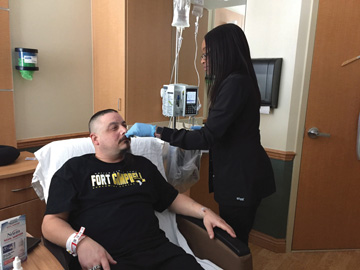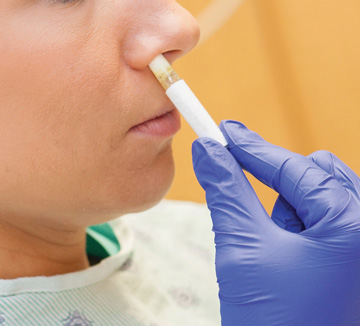Nasal decolonization programs target both methicillin-susceptible S. aureus (MSSA) and MRSA. Bacteria look for reservoirs where they can live, thrive and replicate. For MSSA and MRSA, that’s in the anterior nares of the nose.
This is an issue in outpatient facilities because people naturally sneeze, cough and touch their faces, actions that lead to constant contamination of perioperative environments with S. aureus. Staff who practice in these environments
can then contribute to the transmission of this endogenous bacteria to other patients and surfaces. Decolonization is crucial because S. aureus is a major contributor of healthcare associated infections (HAIs), including central
line-associated bloodstream infections (BSI), ventilator-associated pneumonias and, of course, SSIs.
An estimated 30% of the population is colonized, and somewhere between 70% to 80% of SSIs come from S. aureus strains in patients’ own nares. Additionally, although other risk factors exist that increase the risk of S. aureus
infections, research has shown that MRSA and MSSA carriers are more likely to suffer SSIs with S. aureus than non-carriers. Bottom line: Based on the numbers, nasal decolonization is one method you should implement to help reduce
infection risk.
The primary antibiotic option for decolonization is mupirocin, a nasal ointment. It’s very effective, but the drawback is time. It takes up to five days for the product to be the most effective against S. aureus bacteria. Another
challenge with mupirocin: High use of it can lead to increased antibiotic resistance.
The other option — one that’s especially appealing for outpatient facilities — is the use of nasal antiseptics, products that are alcohol- or povidone-iodine-based. In addition to being much more convenient for patients (most
patients don’t want to put mupirocin ointment in their nose), these povidone-iodine and alcohol-based antiseptics can be applied to patients preoperatively and are effective immediately. There are also no known issues of bacteria
resistance, and you don’t need to worry about patients complying with an onerous administration regimen. After all, with mupirocin, there’s no way to monitor if they completed the twice-a-day regimen for five days prior to
surgical procedures. It’s worth noting that this also goes for the application of chlorhexidine gluconate (CHG) wipes patients are often asked to use at home. If these wipes aren’t applied properly for five days before surgery,
they may not be fully effective in lowering the colonization burden on their skin, so staff generally apply antiseptic swabs and CHG wipes to patients immediately before surgeries.
.svg?sfvrsn=be606e78_3)


.svg?sfvrsn=56b2f850_5)